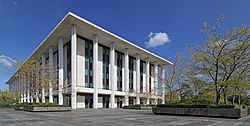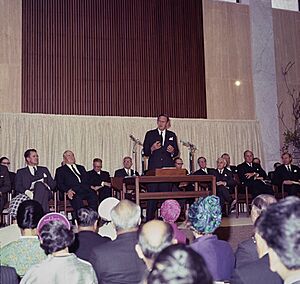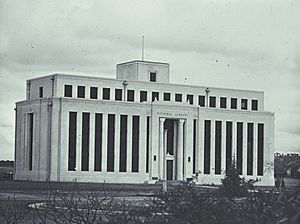National Library of Australia facts for kids
Quick facts for kids National Library of Australia |
|
|---|---|
 |
|
| Type | Reference library |
| Scope | Commonwealth of Australia |
| Established | 23 March 1961 |
| Reference to legal mandate | National Library Act 1960 |
| Location | Canberra, Australian Capital Territory |
| Coordinates | 35°17′47″S 149°07′46″E / 35.29639°S 149.12944°E |
| Collection | |
| Items collected |
|
| Size | 6.93 million items |
| Criteria for collection | Publications made available to the Australian public |
| Legal deposit | Digital and hard-copy Australian published materials |
| Other information | |
| Budget | A$100,000,000 (2025–26) |
| Director | Marie-Louise Ayres |
| Staff | 400 (2016) |
The National Library of Australia (NLA) is Australia's biggest reference library. It used to be called the Commonwealth National Library and the Commonwealth Parliament Library. Its main job is to collect and keep a huge range of materials about Australia and its people. This makes it Australia's official national library. You can find it in Parkes, a suburb of Canberra, ACT.
The NLA was officially created in 1960 by a special law called the National Library Act. By June 2019, it held over 7.7 million items. Its collection of handwritten documents, called manuscripts, filled about 17,950 metres of shelves. The NLA also runs Trove, a popular online service that helps you discover Australian history and culture. Trove includes the Australian Web Archive and National edeposit (NED). These services offer access to many digitized newspapers, government papers, manuscripts, images, and digital-only materials.
Contents
How the National Library Started
In 1901, when Australia became a federation, the Commonwealth Parliament Library was set up. Its purpose was to serve the new Australian Parliament. From the very beginning, this library wanted to build a collection for the whole nation.
In 1907, a special committee led by Sir Frederick William Holder set a big goal. They wanted to create a "great Public Library" in the future capital city. They imagined it would be like the famous Library of Congress in Washington, USA. This library would be worthy of Australia, holding literature from all over the world and from all times.
From 1923, the library used two names at the same time. It was called the Commonwealth National Library for its national collection. It was also known as the Commonwealth Parliament Library for its parliamentary collection.
In 1957, a group called the Paton Committee suggested that the National Library should be its own independent body. This idea became a reality in 1960. The National Library Act 1960 was passed, creating the National Library of Australia as a separate institution.
The Library Building

The first National Library building was on Kings Avenue, Canberra. It was designed by Edwin Hubert Henderson and built in 1934. Only one part of the planned building was finished, partly because of World War II. By 1957, it was clear this building was too small for a national library. It was later used by the Canberra Public Library Service. The building was removed in 1968 to make way for the Edmund Barton Building.
In 1963, Prime Minister Robert Menzies announced plans for a new, much larger National Library building. The current library building opened on August 15, 1968. Prime Minister John Gorton officially opened it. The building is in Parkes and was designed by Bunning and Madden. It has a style called Late Twentieth Century Stripped Classical.
Inside, the main entrance area, called the foyer, is very grand. It has marble decorations and beautiful stained-glass windows by Leonard French. There are also three large tapestries by Mathieu Matégot. Above the main entrance, you can see a copper sculpture by Tom Bass called Lintel Sculpture.
The building is considered very important. It was added to the Australian Commonwealth Heritage List on June 22, 2004. In 2004, a book called A different view : the National Library of Australia and its building art was published. It shared details about the library's architecture and art.
Reading Rooms for Learning
The National Library is a big building with many different reading rooms. These rooms are places where you can study and find information. You can talk to expert staff who can help you with your research. You can also look through the library's reference books, online journals, e-books, and databases.
The reading rooms offer free internet and computers. You can also scan, photocopy, and print documents. If you need a specific item from the collection, you can ask for it here. The Main Reading Room is on the ground floor and has many computers and Wi-Fi. Other special rooms include the Newspaper & Family History zone, the Special Collections Reading Room, the Petherick Reading Room, and Asian Collections.
What the Library Collects
Australian and General Collections
The library collects all kinds of materials made by Australians, for Australians, or about Australia. This includes books, magazines, newspapers, maps, music, and even online publications. It also collects unpublished items like handwritten letters (manuscripts) and recorded stories (oral histories). For example, Hazel de Berg started recording interviews with Australian artists and writers in 1957. She did almost 1300 interviews, helping to save their stories.
A very important part of the Australian collection comes from John A. Ferguson. The library's Australian collections are the best place to find materials about Australia's culture and history. The library is especially strong in collecting items related to the performing arts, like dance.
Besides Australian items, the library has many general overseas books and rare books. It also has excellent collections from Asia and the Pacific region. These help to make the Australian collections even richer. Many older materials are also available on microform, which are tiny images on film.
The library also keeps the National Reserve Braille Collection for people who are blind or have low vision.
Because it's a national library, the NLA has a special rule called "legal deposit." This rule, from the Copyright Act 1968, means that publishers in Australia must send a copy of every new publication to the library. This helps ensure everything published in Australia is saved.
By June 2019, the National Library had over 7.7 million items. Its Australian collections are the most important source for understanding Australia's cultural heritage. The library actively collects works by, editors, and illustrators, no matter where they are published.
The collection includes all types of materials. This ranges from books and journals to websites, pictures, maps, music, and oral history recordings. With help from staff in London, New York City, and Jakarta, the library has built many diverse collections.
About 94.1% of the library's collection was catalogued by July 2019. This means over 5.4 million items can be found using the library's online search system.
Digital Collections: Online Treasures
The library is a leader in saving digital information. Since 1996, it has kept an online archive of Australian websites called the Pandora Archive. In March 2019, the Australian Web Archive was launched. It combines PANDORA, the Australian Government Web Archive, and other Australian websites. In 2019, the government gave the library A$10 million over four years to help digitize more items.
By June 2019, the library had digitized over 5.5 million images. Many of these can be viewed directly online.
Since 2016, a change to the Copyright Act means that all digital-only content must also be sent to the library. Since May 2019, the NLA has run the National edeposit (NED) service. This service works with state libraries across Australia to collect and store digital publications.
Asian Collections: A Window to Asia
The library has the largest collection of materials about Asia in Australia. It also has the biggest collection of Asian language materials in the Southern Hemisphere. This collection includes over half a million books, plus many online resources. The library collects materials about all Asian countries in Western languages. It also collects materials in many Asian languages, such as Chinese, Japanese, Korean, Indonesian, Thai, and Vietnamese.
The library has also bought important collections from researchers and book lovers. These include collections on topics like Portuguese history in Asia, Sri Lanka, Indo-China, and Japan.
You can search for items in the Asian Collections using the National Library's main online catalogue.
Pictures and Manuscripts: Stories from the Past
The National Library has a huge collection of pictures and manuscripts. Manuscripts are handwritten documents. The manuscript collection has about 26 million separate items. These items fill over 10,492 metres of shelf space. Most of this collection is about Australia. However, there are also important items about Papua New Guinea, New Zealand, and the Pacific. Some European and Asian manuscripts are also part of older book collections.
The Australian manuscript collections cover history from the 18th century (when Europeans first explored and settled) to today. Many strong parts of the collection are from the 1890s onwards. It includes many amazing individual items. For example, you can find the journal of James Cook from his ship, the HM Bark Endeavour. This journal was added to the Memory of the World Register in 2001. Other famous items include the diaries of Robert O'Hara Burke and William John Wills from their expedition. You can also see Charles Kingsford Smith's and Charles Ulm's flight log for the Southern Cross plane.
The collection includes papers from many different people and families. These include politicians, artists, writers, and people from the farming industry and religion. Some examples are the papers of Alfred Deakin, Sir John Latham, Sir Hans Heysen, Vance Palmer, Nettie Palmer, Manning Clark, and David Williamson. The papers of Eddie Mabo and James Cook were also added to UNESCO's Memory of the World Programme Register in 2001.
The library also has records from many national groups that are not part of the government. These include records from political parties like the Liberal party and the A.L.P. It also has records from groups like the R.S.L. and the Australian Ballet. Finally, the library has about 37,000 reels of microfilm of manuscripts and old records. Most of these were collected from overseas and are about Australia and the Pacific.
The National Library's Pictures collection focuses on Australian people, places, and events. It covers everything from early European exploration to modern times. Artworks and photographs are collected mainly for the information they provide. They are important historical documents.
The collection includes photographs, drawings, watercolours, oil paintings, and sculptures.
Ephemera: Everyday History
The library has a large collection of printed ephemera. This term refers to small, temporary printed items. These have been collected since the early 1960s and also include older materials. Examples are small publications, leaflets, invitations, cards, menus, and even junk mail. It also includes larger items like theatre programmes or shop catalogues. They are chosen based on their information, design, and how well they show a certain time period.
One important part is the Performing Arts Ephemera collection (PROMPT). This collection is further divided by person or topic. For instance, there is the J.C. Williamson collection of theatre items. It also includes items about performers like Dame Nellie Melba and Kylie Minogue. Since about 2017, volunteers have been using the PROMPT collection to add information to the AusStage database. The J.C. Williamson collection is shared among six different organizations, including the NLA. Both AusStage and the J.C. Williamson collection were added to the UNESCO Australian Memory of the World Register in 2021.
Library Services
The National Library of Australia helps lead other Australian libraries in creating and managing online services. This makes it easier for everyone to find and use information. It offers services to libraries, publishers, and the general public. If you live in Australia, you can become a member to get extra services.
Here are some of the services:
- For publishers:
- The Prepublication Data Service helps Australian publishers get ISSNs and ISMNs for their books and magazines.
- National edeposit (NED) helps publishers meet the "legal deposit" rule. The NLA runs this service. Publishers send all their digital-only content published in Australia directly to NED. This content is then stored and made available to libraries and the public.
- For librarians:
- The Australian National Bibliographic Database (ANBD) is a huge list of resources. Libraries Australia, a paid service, offers free access to it. Libraries use it to find books, build their collections, and lend items to each other.
- The National Libraries Gateway helps libraries connect.
- Online, for everyone:
- The Australian Web Archive saves Australian websites. It includes PANDORA (started in 1996), the Australian Government Web Archive, and websites ending in ".au".
- The National Library of Australia Catalogue lets you search for all the resources available at the NLA.
- "Ask a Librarian" is a service where you can get help with research or ask questions about the library.
Trove: Your Online Discovery Tool
The online services mentioned above, and many more, are all available through Trove. Trove was launched in 2009. It's like a super search engine for Australian libraries. It brings together information from many major libraries across Australia. Trove's most famous feature is its huge collection of digitized Australian newspapers. Most of the NLA's online search tools are now part of Trove. This service helps you find resources about Australia and Australians that might be hard to find with regular search engines.
Publishing Books
The library also publishes its own books. These are non-fiction and children's books that explore the library's collections. They cover topics like history, natural history, and art. NLA Publishing has won several Eve Pownall Awards for Information Books.
Becoming a Member
Anyone living in Australia can sign up for free membership with the library. You get a membership card sent to your home address. Being a member gives you extra benefits. You can ask for items to use in the reading rooms. You can also access some special online resources from home, like the full text of Encyclopaedia Britannica. You can order digital copies of some items. If you can visit the library in person, you can also get inter-library loans to use in the reading rooms.
Leaders of the National Library
The people who have led the National Library of Australia are called Directors-General. Here is a list of those who have held this important role:
| Number | Leader | Title | Started | Ended | Time in office | Notes |
|---|---|---|---|---|---|---|
| 1 | Arthur Wadsworth | Interim Commonwealth Parliamentary Librarian | 1901 | 1927 | 26 years | |
| 2 | Kenneth Binns CBE | Commonwealth Parliamentary Librarian | 1927 | 1947 | 20 years | |
| 3 | Harold Leslie White CBE | National Librarian | 1947 | 1970 | 23 years | |
| 4 | Allan Percy Fleming CBE | 1970 | 1974 | 4 years | ||
| 5 | George Chandler | Director-General | 1974 | 1980 | 6 years | |
| 6 | Harrison Bryan AO | 1980 | 1985 | 5 years | ||
| 7 | Warren Horton AM | 1985 | 1999 | 14 years | ||
| 8 | Jan Fullerton AO | 1999 | 2010 | 11 years | ||
| 9 | Anne-Marie Schwirtlich | 2011 | 2017 | 6 years | ||
| 10 | Marie-Louise Ayres | 2017 | present | 8 years |
Supporting the Library
In 2016, there were worries that funding for Trove might be cut. A public campaign helped. In December 2016, the government promised A$16.4 million over four years to support Trove.
By early 2020, more and more people were using digital services. The National Library needed to manage this with fewer staff. So, it made some changes to its staff and how it operates.
See also
 In Spanish: Biblioteca Nacional de Australia para niños
In Spanish: Biblioteca Nacional de Australia para niños
- List of national and state libraries
- National and State Libraries Australia
- Parliamentary Triangle, Canberra
- Parliamentary Library of Australia




